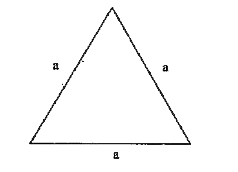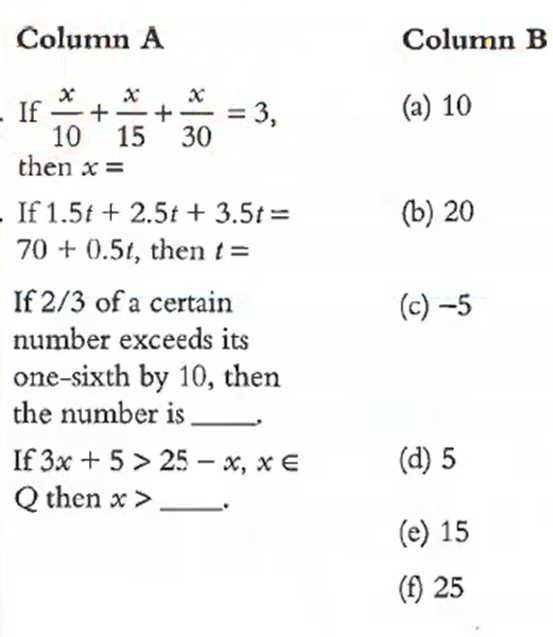Look at the following matchsticks patterns of square given below. The squares are not separate as there are two adjoined adjacent squares have common match stick. Observe the patterns and find the rule that gives the number of matchsticks in terms of the number of squares.
 Solution in Punjabi
Solution in Punjabi
The correct Answer is:3x+1
Step by step video, text & image solution for Look at the following matchsticks patterns of square given below. The squares are not separate as there are two adjoined adjacent squares have common match stick. Observe the patterns and find the rule that gives the number of matchsticks in terms of the number of squares. by Maths experts to help you in doubts & scoring excellent marks in Class 6 exams.
Updated on:21/07/2023Topper's Solved these Questions
Similar Questions
Each side of equilateral triangle is denoted by 'a' then express the perimeter of the triangle using 'a'.

View SolutionPick the algebraic expressions and the arithmetic expressions from the following :
2l−3
View SolutionHow many lines can pass through a point ?
View Solution(a) Look at the following matchstick pattern of squares (Fig 11.6). The squares are not separate. Two neighbouring squares have a common matchstick. Observe the patterns and find the rule that gives the number of matchsticks in terms of the number of squares. (Hint : If you remove the vertical stick at the end, you will get a pattern of Cs.)(b) Fig 11.7 gives a matchstick pattern of triangles. As in Exercise 11 (a) above, find the general rule that gives the number of matchsticks in terms of the number of triangles.

View SolutionMatch the following Column A to Column B

View SolutionThe inequation represented by the graph given below is :
View SolutionThe inequation that best describes the graph given below is _________
View SolutionIf the figure given below ( not to scale), ABCD, CBEF and EGHF are three congruent squares. Find ∠FAE+∠HAG.
View SolutionWhat is the distance OA for the square shown in figure :- ltimg src="https://d10lpgp6xz60nq.cloudfront.net/physics_images/ALN_PHY_R05_E01_015_Q01.png" width="80%"gt
View Solution(a) तीलियों से बने हुए वर्गों के निचे दिये प्रतिरूपों को देखिए (आकृति 11.6)। ये वर्ग अलग-अलग नहीं है। दो संलग्न वर्गों में एक तीली उभयनिष्ठ है। इस प्रतिरूप को देखिए और वह नियम ज्ञात कीजिए जो वर्गों की संख्या के पदों में आवश्यक तीलियों की संख्या देता है। (संकेत : यदि आप अंतिम ऊर्ध्वाधर तीली को हटा दें, तो आपको C का प्रतिरूप प्राप्त हो जायगा) ।
(b) आकृति 11.7 तीलियों से बना त्रिभुजों का एक प्रतिरूप दर्शा रही है। उपरोक्त प्रश्न 11
(a) की तरह, वह व्यापक नियम ज्ञात कीजिए जो त्रिभुजों की संख्या के पदों में आवश्यक तीलियों की संख्या देता है।
View Solution(a) Look at the following matchstick pattern of squares (Fig 11.6). The squares are not separate. Two neighbouring squares have a common matchstick. Observe the patterns and find the rule that gives the number of matchsticks in terms of the number of squares. (Hint : If you remove the vertical stick at the end, you will get a pattern of Cs.)(b) Fig 11.7 gives a matchstick pattern of triangles. As in Exercise 11 (a) above, find the general rule that gives the number of matchsticks in terms of the number of triangles.
View SolutionLook at the patterns below the squares made of matchsticks (following figure). These classes are not separate. There is a matchstick in the enclosed sections. Look at this pattern and find the rule that gives the number of matchsticks required in terms of the number of squares. (Hint: If you beat the last hurdle stick, you will get a copy of C)
View Solution(a)Look at the following matchstick pattern of squares (Fig 11.6). The squares are not separate. Two neighbouring squares have a common matchstick. Observe the patterns and find the rule that gives the number of matchsticks in terms of the number of squares. (Hint: If you remove the vertical stick at the end, you will get a pattern of Cs.)
View Solution(a)Look at the following matchstick pattern of squares (Fig 11.6). The squares are not separate. Two neighbouring squares have a common matchstick. Observe the patterns and find the rule that gives the number of matchsticks in terms of the number of squares. (Hint: If you remove the vertical stick at the end, you will get a pattern of Cs.)(c)
View Solution(a)Look at the following matchstick pattern of squares (Fig 11.6). The squares are not separate. Two neighbouring squares have a common matchstick. Observe the patterns and find the rule that gives the number of matchsticks in terms of the number of squares. (Hint: If you remove the vertical stick at the end, you will get a pattern of Cs.)(d)
View SolutionLook at the following matchstick pattern of squares. The squares are not separate. Two neighboring squares have a common matchstick. Observe the patterns and find the rule that gives the number of matchsticks in terms of the number of squares. (Hint: If you remove the vertical stick at the end, you will get a pattern of Cs.)
View Solution
